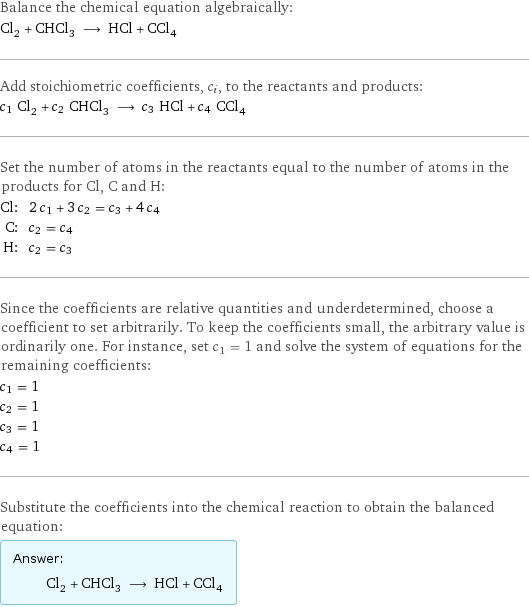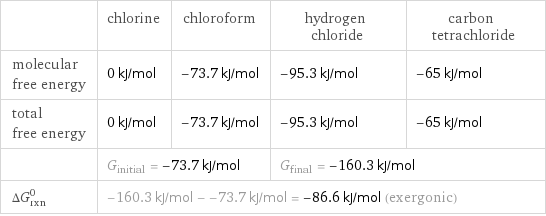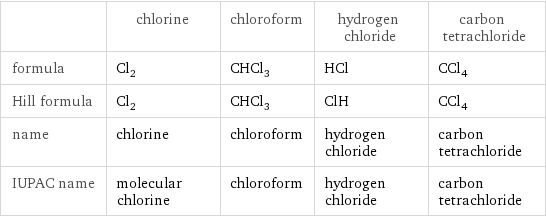Input interpretation

Cl_2 chlorine + CHCl_3 chloroform ⟶ HCl hydrogen chloride + CCl_4 carbon tetrachloride
Balanced equation

Balance the chemical equation algebraically: Cl_2 + CHCl_3 ⟶ HCl + CCl_4 Add stoichiometric coefficients, c_i, to the reactants and products: c_1 Cl_2 + c_2 CHCl_3 ⟶ c_3 HCl + c_4 CCl_4 Set the number of atoms in the reactants equal to the number of atoms in the products for Cl, C and H: Cl: | 2 c_1 + 3 c_2 = c_3 + 4 c_4 C: | c_2 = c_4 H: | c_2 = c_3 Since the coefficients are relative quantities and underdetermined, choose a coefficient to set arbitrarily. To keep the coefficients small, the arbitrary value is ordinarily one. For instance, set c_1 = 1 and solve the system of equations for the remaining coefficients: c_1 = 1 c_2 = 1 c_3 = 1 c_4 = 1 Substitute the coefficients into the chemical reaction to obtain the balanced equation: Answer: | | Cl_2 + CHCl_3 ⟶ HCl + CCl_4
Structures

+ ⟶ +
Names

chlorine + chloroform ⟶ hydrogen chloride + carbon tetrachloride
Reaction thermodynamics
Gibbs free energy

| chlorine | chloroform | hydrogen chloride | carbon tetrachloride molecular free energy | 0 kJ/mol | -73.7 kJ/mol | -95.3 kJ/mol | -65 kJ/mol total free energy | 0 kJ/mol | -73.7 kJ/mol | -95.3 kJ/mol | -65 kJ/mol | G_initial = -73.7 kJ/mol | | G_final = -160.3 kJ/mol | ΔG_rxn^0 | -160.3 kJ/mol - -73.7 kJ/mol = -86.6 kJ/mol (exergonic) | | |
Equilibrium constant
![Construct the equilibrium constant, K, expression for: Cl_2 + CHCl_3 ⟶ HCl + CCl_4 Plan: • Balance the chemical equation. • Determine the stoichiometric numbers. • Assemble the activity expression for each chemical species. • Use the activity expressions to build the equilibrium constant expression. Write the balanced chemical equation: Cl_2 + CHCl_3 ⟶ HCl + CCl_4 Assign stoichiometric numbers, ν_i, using the stoichiometric coefficients, c_i, from the balanced chemical equation in the following manner: ν_i = -c_i for reactants and ν_i = c_i for products: chemical species | c_i | ν_i Cl_2 | 1 | -1 CHCl_3 | 1 | -1 HCl | 1 | 1 CCl_4 | 1 | 1 Assemble the activity expressions accounting for the state of matter and ν_i: chemical species | c_i | ν_i | activity expression Cl_2 | 1 | -1 | ([Cl2])^(-1) CHCl_3 | 1 | -1 | ([CHCl3])^(-1) HCl | 1 | 1 | [HCl] CCl_4 | 1 | 1 | [CCl4] The equilibrium constant symbol in the concentration basis is: K_c Mulitply the activity expressions to arrive at the K_c expression: Answer: | | K_c = ([Cl2])^(-1) ([CHCl3])^(-1) [HCl] [CCl4] = ([HCl] [CCl4])/([Cl2] [CHCl3])](../image_source/e0e3df3e9845f60563842e1d6a569f89.png)
Construct the equilibrium constant, K, expression for: Cl_2 + CHCl_3 ⟶ HCl + CCl_4 Plan: • Balance the chemical equation. • Determine the stoichiometric numbers. • Assemble the activity expression for each chemical species. • Use the activity expressions to build the equilibrium constant expression. Write the balanced chemical equation: Cl_2 + CHCl_3 ⟶ HCl + CCl_4 Assign stoichiometric numbers, ν_i, using the stoichiometric coefficients, c_i, from the balanced chemical equation in the following manner: ν_i = -c_i for reactants and ν_i = c_i for products: chemical species | c_i | ν_i Cl_2 | 1 | -1 CHCl_3 | 1 | -1 HCl | 1 | 1 CCl_4 | 1 | 1 Assemble the activity expressions accounting for the state of matter and ν_i: chemical species | c_i | ν_i | activity expression Cl_2 | 1 | -1 | ([Cl2])^(-1) CHCl_3 | 1 | -1 | ([CHCl3])^(-1) HCl | 1 | 1 | [HCl] CCl_4 | 1 | 1 | [CCl4] The equilibrium constant symbol in the concentration basis is: K_c Mulitply the activity expressions to arrive at the K_c expression: Answer: | | K_c = ([Cl2])^(-1) ([CHCl3])^(-1) [HCl] [CCl4] = ([HCl] [CCl4])/([Cl2] [CHCl3])
Rate of reaction
![Construct the rate of reaction expression for: Cl_2 + CHCl_3 ⟶ HCl + CCl_4 Plan: • Balance the chemical equation. • Determine the stoichiometric numbers. • Assemble the rate term for each chemical species. • Write the rate of reaction expression. Write the balanced chemical equation: Cl_2 + CHCl_3 ⟶ HCl + CCl_4 Assign stoichiometric numbers, ν_i, using the stoichiometric coefficients, c_i, from the balanced chemical equation in the following manner: ν_i = -c_i for reactants and ν_i = c_i for products: chemical species | c_i | ν_i Cl_2 | 1 | -1 CHCl_3 | 1 | -1 HCl | 1 | 1 CCl_4 | 1 | 1 The rate term for each chemical species, B_i, is 1/ν_i(Δ[B_i])/(Δt) where [B_i] is the amount concentration and t is time: chemical species | c_i | ν_i | rate term Cl_2 | 1 | -1 | -(Δ[Cl2])/(Δt) CHCl_3 | 1 | -1 | -(Δ[CHCl3])/(Δt) HCl | 1 | 1 | (Δ[HCl])/(Δt) CCl_4 | 1 | 1 | (Δ[CCl4])/(Δt) (for infinitesimal rate of change, replace Δ with d) Set the rate terms equal to each other to arrive at the rate expression: Answer: | | rate = -(Δ[Cl2])/(Δt) = -(Δ[CHCl3])/(Δt) = (Δ[HCl])/(Δt) = (Δ[CCl4])/(Δt) (assuming constant volume and no accumulation of intermediates or side products)](../image_source/3501a1d9be1a464544ec68610b24e70c.png)
Construct the rate of reaction expression for: Cl_2 + CHCl_3 ⟶ HCl + CCl_4 Plan: • Balance the chemical equation. • Determine the stoichiometric numbers. • Assemble the rate term for each chemical species. • Write the rate of reaction expression. Write the balanced chemical equation: Cl_2 + CHCl_3 ⟶ HCl + CCl_4 Assign stoichiometric numbers, ν_i, using the stoichiometric coefficients, c_i, from the balanced chemical equation in the following manner: ν_i = -c_i for reactants and ν_i = c_i for products: chemical species | c_i | ν_i Cl_2 | 1 | -1 CHCl_3 | 1 | -1 HCl | 1 | 1 CCl_4 | 1 | 1 The rate term for each chemical species, B_i, is 1/ν_i(Δ[B_i])/(Δt) where [B_i] is the amount concentration and t is time: chemical species | c_i | ν_i | rate term Cl_2 | 1 | -1 | -(Δ[Cl2])/(Δt) CHCl_3 | 1 | -1 | -(Δ[CHCl3])/(Δt) HCl | 1 | 1 | (Δ[HCl])/(Δt) CCl_4 | 1 | 1 | (Δ[CCl4])/(Δt) (for infinitesimal rate of change, replace Δ with d) Set the rate terms equal to each other to arrive at the rate expression: Answer: | | rate = -(Δ[Cl2])/(Δt) = -(Δ[CHCl3])/(Δt) = (Δ[HCl])/(Δt) = (Δ[CCl4])/(Δt) (assuming constant volume and no accumulation of intermediates or side products)
Chemical names and formulas

| chlorine | chloroform | hydrogen chloride | carbon tetrachloride formula | Cl_2 | CHCl_3 | HCl | CCl_4 Hill formula | Cl_2 | CHCl_3 | ClH | CCl_4 name | chlorine | chloroform | hydrogen chloride | carbon tetrachloride IUPAC name | molecular chlorine | chloroform | hydrogen chloride | carbon tetrachloride